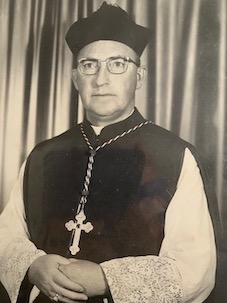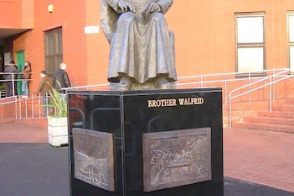The legacy of an Irish missionary in South Africa

Bishop John Durkin
On 16 November, the Diocese of Tzaneen in South Africa celebrates the 50th anniversary of its establishment by decree of Pope Paul VI with Irish-born, John Durkin, as its first bishop. This is a typical story of how Irish and other missionaries built the Catholic Church across the continent of Africa. It also illustrates how their legacy lives on through the ministry of local and indigenous priests, nuns and brothers whom they recruited and trained.
But who was John Durkin? He was born in the townland of Glenavoo, Aclare, Co Sligo on 10 February 1913, one of six children - four girls and two boys - of Tom Durkin and Catherine Goldrick. He received the sacraments in Largan Church - locally known as The Lake Church on the shore of Lough Talt and beside The Windy Gap in the Ox Mountains. He attended the nearby Largan School and went onto the Apostolate School of the Missionaries of the Sacred Heart (MSC) in Cork where he matriculated in 1930.
John entered the MSC Novitiate in Bree in Belgium and made his first profession in 1935. He attended Louvain Catholic University in France but with fears of war growing in Europe, he finished his studies at the newly established MSC House at Moyne Park in Co. Galway. He was ordained a priest in 1937.
The old family cottage at Glenavoo is now a well-kept holiday home in a picturesque setting for members of the Durkin family. I recently had the privilege of meeting three of Bishop Durkin's nieces there - Sr Angela - a Marist nun in nearby Tubbercurry; Nuala Durkin who lives in the UK and Frances Judge who lives in nearby Bonniconlon parish. Curious to know what influenced the young boy to join the priesthood, they told me that an MSC priest, Fr Michael Nealon, who was from the area was definitely an influence.
The young priest's first appointment in 1939 was to New Guinea along with three colleagues. As WWII spread, he was imprisoned in a Japanese concentration camp in Rabaul from 1942 - 1945. Two colleagues - Frs Murphy and Culhane - were killed by the invaders. He had a narrow escape from death. He was due to be executed on 22 August, but the Americans freed the prisoners of war on 6 August.
Close colleagues told me that he did not speak much about the hardship and torture he endured but told of how the prisoners dug tunnels to protect themselves from bomb raids and they were conscious that an ammunition dump was close to the camp. He also told how home-made cigars were good to keep the mosquitoes away. With no medication, starvation was the order of things. Some survived thanks to local people throwing food to them over the fence at night despite the risks to their own lives.
Fr Durkin came to Ireland on a holiday in 1949. I recall an uncle of mine, Anthony Hennigan, telling me how the priest visited the Hennigan home and other relations in the townland of Drumsheen in the neighbouring parish of Bonniconlon on the Mayo side of the Ox Mountains. Fr Durkin's father was born and reared in Glenree near Bonniconlon. During that home visit he did not realise then that a new chapter in his life was about to begin as the MSCs had taken pastoral responsibility for a region in the Northern Transvaal in South Africa.
On 8 December 1950, Fr Durkin arrived there in Louis Trichardt, along with his former companion in New Guinea, Fr William Cadogan. After studying the Sepedi language at Doornspruit, near Pietersburgh, he took charge of St Scholastica Mission which became the responsibility of the MSCs in January 1952. On his arrival, one Benedictine monk and five Dominican Sisters, four teachers and a cook looked after this remote mission station and its two outstations and the school.
Four years later he found himself missioned in the Eastern Cape in Port Elizabeth Diocese where he also served as superior of the MSC community there. An Irish MSC serving there was the late Fr Jerry O'Riordan who told me some years ago about Fr Durkin's "inspiring and visionary approach." He described him as "kind and caring… a man with heart, loving care and vision… the greatest superior of the MSC."
In the early 1960s when the Lumko Missiological Institute was set up at Germiston in Gauteng Province the MSCs were approached to provide qualified staff. Mgr Durkin was very supportive of the initiative and provided a number of priests, including Fr Hugh Slattery from Nenagh in Co Tipperary. They developed and provided courses in local languages and social anthropology for new missionaries arriving. Training was also provided for catechists, and other departments were added to deliver training in pastoral and biblical studies with German diocesan priests in charge.
The Institute produced a lot of practical training materials for various lay ministries which were widely used around the world. For example, in 1978, Fr Hugh Slattery co-edited Pastoral Orientation in a Changing World. John Durkin - a quiet but an inspiring visionary - played a key role in the early years of the Institute.
Greater things were in store for him as a papal decree in December 1962 established the territory in the Northern Transvaal as the Prefecture Apostolic of Louis Trichardt. On 14 May 1963, he was installed as Prefect Apostolic with over 40 Irish priests at the ceremony. One of his immediate tasks was to participate in the Vatican Council from then until 1965.
Now, a monsignor, he administered the new Prefecture until it was elevated to the status of diocese by Pope Paul VI on 16 November 1972 and he was installed as its first bishop. He was ordained to the episcopacy on 4 March 1973 at Our Lady of the Sacred Heart Mission, Dwars River. It was a very big occasion with around 4,000 Africans, some hundreds of white people, 22 prelates, and about 50 priests in attendance. His brother, Michael Joe travelled to South Africa for the ceremony.
In June of that year, Bishop Durkin, visited his family in Ireland. Sligo Corporation granted him the Freedom of the City on 4 July. He signed the ceremonial book: John T. Durkin, Louis Trichardt Tzaneen, S. Africa. That was a huge civic honour for the young boy who had been reared on a tiny farm at the foot of the Ox Mountains, and where very little would have been known then about New Guinea or South Africa.
The African Church was sometimes ahead of the church in Ireland and the West generally. In 1974, Tzaneen Diocese began to train African deacons from among the ranks of catechists. By 1976, there were two candidates in their second year and seven in first year. When Bishop Durkin retired in 1984, he had ordained four married African deacons.
He had a very clear sense of the role of missionaries in building the church in Africa. In an interview with the editor of the The Annals of Our Lady of the Sacred Heart, he said: "In Europe, the seed of the Gospel has grown into a tree. It is the seed we must transplant and not the tree. The seed must grow into an African and not a European Church. Very often we bring with us Western forms that are quite unnatural to their psychological make-up and altogether foreign to the sensitivity and genius of Africans."
When asked about African traditions of singing and rhythm at religious services, he said: "They love to worship through song. You know, there is a great difference between their rendering of a European melody in church, which is half-hearted and spiritless, and the gusto with which they sing an African song. The power of the African rhythm is fully exploited by the witch doctor and mob orator. Why not turn this mighty force to the church's advantage?"
In the Diocese of Tzaneen in 1982, there were 39 nuns, 12 of them local and 27 expatriates. Ten of the sisters were over 70 years of age. The Bishop wrote that there was no possibility of them being replaced. Obviously, he was alert to the emerging fall in vocations to the religious life in Ireland and in the West generally.
The contribution of the MSCs to the diocese was enormous. In 1982, it had 21 priests, 20 of them MSCs and one a retired Benedictine. The four Catholic schools educated 946 students. By 1985, there were 10 mission clinics, treating 114,310 patients annually. Within five years, the remaining seven clinics treated 300,000 patients annually. That is a good example of how the missionaries provided education and health services when the state was unable to do so. They did that with the generous financial support of donors back in Ireland.
Bishop Durkin retired on 22 June 1984 due to ill health but continued to work as a missionary in the Phalaborwa district. In 1987, he celebrated the golden jubilee of his ordination, first in Tzaneen and later at a group celebration of jubilees at the MSC House in Cork. He loved celebrations and jubilees. "They are good and fulfil a human need to affirm and be affirmed on the pilgrim way. They fulfil a spiritual need in making us climb the mountain, survey the countryside and look into the horizon and even strain our vision. It is good to be alive on such occasion," he said.
On 27 September 1990, he died peacefully in the Little Company of Mary Hospital in Pretoria at the age of 77 years. He was buried beside the Cathedral in Tzaneen. He was succeeded as bishop by fellow MSC, Fr Hugh Slattery who served in the role until January 2010. He was succeeded by Bishop João Noé Rodrigues who was born in Cape Town.
As the Irish missionary era comes to a close, Bishop Slattery is now the last remaining MSC in the diocese. The work that the young man from Glenavoo in Co Sligo started and was continued by his colleague from Co Tipperary is now being carried forward by a native son of South Africa. The story of that unique legacy was the basis of my 2016 book - The Legacy of Irish Missionaries Lives On for which Ballina woman and former President of Ireland, Mary Robinson, wrote the Foreword. Tzaneen Diocese now has nine diocesan and 19 religious priests, 28 nuns and three permanent deacons as it celebrates the 50th anniversary of its establishment.
Matt Moran is a journalist and author living in Cork. He has published The Legacy of Irish Missionaries Lives On, and The Theology of Integral Human Development: the role of faith in international development and public affairs - both available from www.buythebook.ie. He is currently working on another book - The Cultural Colonisation of Africa by the West.


















